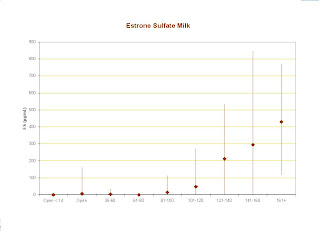Tuesday, July 17, 2007
So Many Samples........
The last few weeks have kept me quite busy in the lab. I have tested many of the serum and milk samples from Nobis Dairy for estrone sulfate using the Confirm assay from Australia. The assay that had appeared so promising has some unredeeming qualities. The intra-assay and inter-assay variability is very high. The assay is not very sensitive making it difficult to distinguish estrone sulfate levels below 150-200 pg/mL. This is why the assay was only marketed for confirming pregnancy after 120 days. What we need to determine is whether this is due to a large variability in estrone sulfate levels of cows in early pregnancy, a physiological spike in estrone sulfate at 120 days of pregnancy or if the assay is not sensitive enough. This is evident in the following charts where a sharp increase in estrone sulfate is seen at 120 day pregnancies. To help answer our question, we have started using a human estrone kit from Ann Arbor. We are able to use an estrone kit because it claims 100% cross reactivity with estrone sulfate. The kit seems to be able to pick up estrone sulfate in bovine serum and milk. We have tested various dilutions with this very sensitive kit to determine what dilution yields the most accurate results. I have finally received more Ridgeway kits and I am catching up on progesterone testing. Progesterone ELISAs may have more commercial promise than originally thought, as we have already had questions from clients inquiring whether we can offer a progesterone assay cheaper than the labs they are currently using to monitor reproductive performance in cattle herds. We will also start analyzing the combined estrone sulfate, progesterone, and herd records data.
Wednesday, July 11, 2007
Estrone Sulfate: Milk
Estrone Sulfate: Serum

This chart represents the data we have compiled on estrone sulfate levels in the serum of lactating Holsteins. Cows are divided into early open, open, and pregnant categories. Pregnant cows are divided into groups based on the number of days they have carried a calf. Each group currently contains between 10 and 20 animals. This number will increase as we sample more animals. The data presented here represents the average, high, and low values of estrone sulfate in picograms/mL for each group of animals. Animals whose individual data points are greatly skewing the average are slated to be retested, but are currently still represented on the data seen here. (To view chart in a larger scale click on image.)
Subscribe to:
Posts (Atom)
